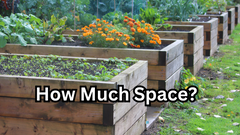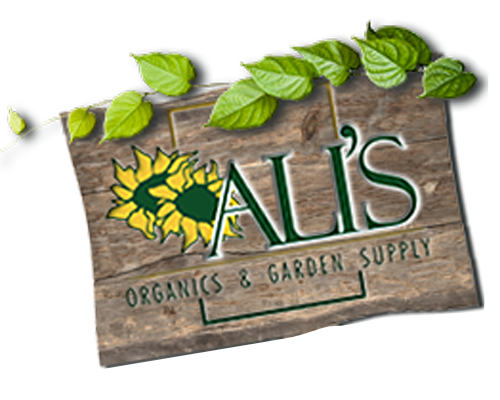How Much Garden Space to Feed a Family of 4
Posted January 25, 2025

Below is a tiered guideline to help you estimate how much garden space might be needed to feed—or at least significantly supplement the diet of—a family of four. Actual results will vary depending on factors like climate, soil fertility, gardening methods, and your family’s eating habits. These tiers focus primarily on vegetables and some fruits rather than 100% self-sufficiency (which typically requires larger acreage, especially for grains and livestock).
Tier 1: Small Supplement (100–200 sq ft)
-
What to Expect
- Fresh salad greens, herbs, and a few seasonal veggies.
- Adds variety and nutrients to your meals but won’t cover all produce needs.
-
Bed Sizes & Layout
- Could be 2–3 raised beds (e.g., 4 ft x 8 ft each).
- Great for square foot gardening methods:
- 1 tomato plant per square foot.
- 4 lettuce plants per square foot.
- 16 radishes or carrots per square foot.
-
Tips
- Succession planting is key—sow new seeds every few weeks to extend harvests.
- Focus on high-value crops (like herbs or greens) you use frequently.
Tier 2: Moderate Production (400–600 sq ft)
-
What to Expect
- Enough produce to supply a family of four with fresh veggies throughout most of the growing season.
- Possibility of small surpluses for canning or freezing.
-
Bed Sizes & Layout
- Could be 5–7 raised beds measuring 4 ft x 10 ft each (totaling ~200–280 sq ft of bed surface), plus some in-ground rows for larger space crops (like squash or corn).
- Combining raised beds and in-ground rows can maximize variety.
-
Tips
- Interplant quick crops (like radishes or salad greens) with slower growers (tomatoes, peppers) to optimize every square foot.
- Practice crop rotation and add compost regularly for ongoing soil fertility.
Tier 3: Near Full Produce Supply (1,000–2,000 sq ft)
-
What to Expect
- Potential for a significant portion of your family’s produce needs across multiple seasons, including root vegetables and storage crops (like potatoes, onions, winter squash).
- Room for small perennial fruit plantings (berries, rhubarb, asparagus).
-
Bed Sizes & Layout
- A mix of larger in-ground beds or rows (e.g., 3–4 wide rows of 20–30 ft each) for bulk crops like potatoes or squash.
- Several raised beds for intensive production of smaller veggies, herbs, and salad greens.
-
Tips
- Use succession planting and season extension (row covers, cold frames) to spread harvest over more months.
- Incorporate vertical growing for cucumbers, pole beans, or vining crops to save space.
Tier 4: High-Level Homegrown (2,000–4,000+ sq ft)
-
What to Expect
- Enough space to supply most—if not all—of your family’s fresh veggies throughout the year, plus extra for canning, freezing, or dehydrating.
- Room for multiple fruit bushes or a small orchard.
- Opportunity to grow grain patches (like corn or small grains) if desired.
-
Bed Sizes & Layout
-
Combination Approach:
- Larger block plantings for staple crops.
- Raised beds or row beds for a diverse variety of annual veggies and herbs.
- Square Foot Gardening can still work in some sections to maximize yield in smaller areas, especially for dense planting of leafy greens.
-
Combination Approach:
-
Tips
- Rotate crops diligently to prevent pest and disease buildup.
- Consider cover crops (like clover or rye) to rejuvenate the soil.
- Make composting a priority—both to handle garden waste and ensure long-term soil fertility.
How Much Can You Grow in Each Square Foot?
- Tomatoes / Peppers: 1 plant per square foot (though many gardeners give tomatoes closer to 2 sq ft for airflow).
- Leaf Lettuce: 4 plants per square foot.
- Root Crops (Carrots, Radishes): Up to 16 plants per square foot.
- Onions / Beets: 9 plants per square foot.
- Bush Beans: 9 plants per square foot.
Square foot gardening is an intensive technique that helps you maximize yields in raised beds with rich soil. In ground-level rows, you can space plants a bit more generously to accommodate machinery or easy weeding.
Key Takeaways
- Small Spaces Still Matter: Even 100 sq ft of well-maintained beds can supplement your family’s diet with fresh greens and herbs.
- Square Foot Gardening: Ideal for maximizing yields in limited areas; know the recommended plant spacing.
- Scale Gradually: Start with a modest space, build your skills and soil health, then expand.
- Soil Health Is Everything: Regularly add compost, rotate crops, and consider cover cropping to maintain fertility.
In short, feeding a family of four from your garden can range from partially supplementing grocery store trips to providing nearly all your produce, depending on how many square feet you can dedicate and how intensively you manage it.



Comments (0 Comments)
There are no comments.
Post Comment